
The Himyarite Kingdom’s Bloody Conversion to Judaism: Passion or Ploy?
The Himyarite Kingdom was established in 110 BC and lasted until 570 AC. It is most often remembered these days as the “Jewish Kingdom”, thanks to the fact that for some time its predominant religion was Judaism. The history of the rise and eventual fall of the Himyarite Kingdom is a bloody one. It is also a fascinating lesson in the impact religious shifts had on the ancient empires.
What was the Himyarite Kingdom?
The Himyarite Kingdom was founded in what is today modern-day Yemen in 110 BC. To its contemporaries, the Greeks and Romans, it was called the Homerite Kingdom. The Himyarite Kingdom's capital was known as Zafar, which was located near the modern city of Sana’a.
- How to Prevent an Invasion? Build a Bridge! The Shaharah Bridge in Yemen, a Bridge of Sighs
- How Two Jewish Rabbis Respected and Protected the Ka'bah of Islam

Location of Himyarite Kingdom and Aksum (Axum) (Trokiodero / CC BY SA 4.0)
According to historical sources, the kingdom was named after its founder, Himyar. The story of the Himyarite Kingdom begins in 110 BC when the tribe of Himyar decided to separate from the Qataban kingdom, another kingdom based in Yemen. They quickly got to work by establishing their capital, Zafar, and changing languages. To differentiate themselves from their past, they adopted the Sabaean language.
Once established, the Himyarites were swift in expanding their borders. Their first major victim was the ancient kingdom of Saba. Saba had been an ancient powerhouse, controlling the entire area for almost a thousand years. However no kingdom lasts forever, and in the year 25 BC, the Romans invaded southern Arabia, severely weakening Saba.
The Himyarites saw their opportunity and went in, conquering the kingdom of Saba, but they failed to wipe out the kingdom altogether. It soon became apparent that the Himyarites had bitten off more than they could chew. The old Saba dog still knew a few tricks, and the Himyarites struggled to maintain a foothold.

The largely abandoned ruins of Bayt Baws, a Himyar-period Jewish settlement. (Rod Waddington / CC BY-SA 2.0)
Around 175 AD, the Himyarites conquered their former masters, the Kingdom of Qataban. Within approximately 200 years, they had essentially conquered two large empires. Impressive.
However, the Himyarite winning streak could not last. They had failed to eradicate both kingdoms completely, and this would have consequences. The first Himyarite kingdom fell apart in the early 2nd century AD, when both Saba and Qataban rose again.
The Himyarites did not accept defeat easily. From 100 AD until 275 AD, the Himyarite Kingdom and the Saba Kingdom were in a near-constant state of war. The Qataban victory was also short-lived. A shadow of their former selves, they were soon conquered by Hadramaut (another power in the area).
The Himyarites eventually regained the upper hand. They reconquered the kingdom of Saba around 275 BC and conquered Hadramaut (including the old Qataban kingdom) in the 4th century AD.
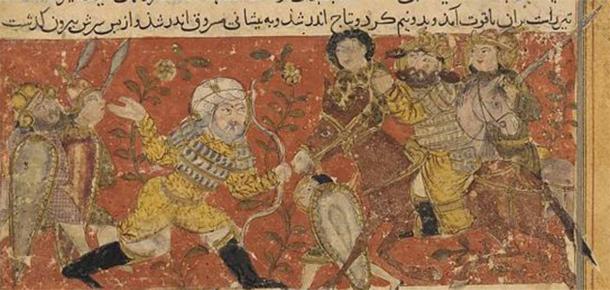
The Battle of Hadramaut, 570 AD, from a Persian miniature (Public Domain)
The Conversion of the Himyarite Kingdom
The Himyarite Kingdom was now huge, consisting of peoples who had once belonged to different kingdoms. The Himyarite leadership needed a way to unite all these diverse peoples, each with their languages, religions, and customs.
The Sabaean language spread quickly throughout the kingdom, and a standard calendar system was introduced. However, it would take nearly one hundred years for changes to religion to become apparent.
Each of the earlier kingdoms that now made up the Himyarite kingdom had once had its own religion. It is likely that one of the reasons for having Judaism as a state religion was to try and bring these disparate groups together under one religious banner.
Using archaeological evidence, we can estimate the date that the Himyarite kings converted to Judaism to around 380 AD. It was at this time that the old polytheistic temples were abandoned. Dedications to the old gods were replaced with references to a new figure called Rahmanan. Rahmanan means “the Lord of Heaven '' or “Lord of Heaven and Earth”.
It is unclear who the first Jewish king of the Himyarite kingdom was, but there are a couple of possibilities. It is thought that religious reform originally began under King Malikikariba Yuha’amin (375-400 AD).
His reign was a stable one, and this is often attributed to his attempts at unifying the nation through religion. It was during his rule that we start to see dedications under the name Rahmanan for him and his sons. It was also King Yuha’amin who built the first mikrab, a house of prayer.
It seems that Yuha’amin began the conversion to Judaism, but it was his son, Tub’a Abu Kariba As’ad (390-420) who finished it. It is believed Abu-Kariba converted whole-heartedly after an expedition into northern Arabia against the Byzantines.
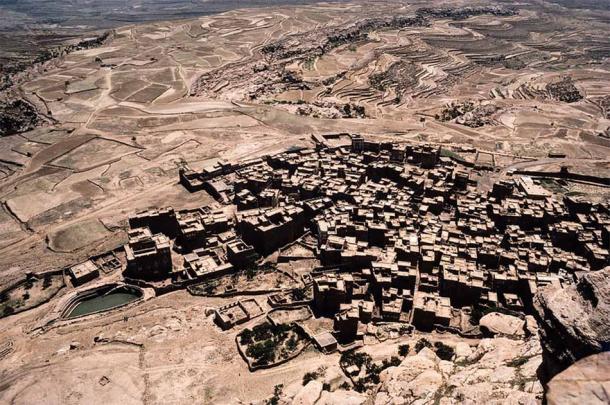
The extent of the still inhabited city of Thula, Yemen (Biblioteca del Arte / CC BY NC ND 2.0)
The Byzantines had hopes of taking the Arabian Peninsula, which would give them control of the lucrative spice trade. Their goal was to do this peacefully by converting the locals to Christianity and establishing a protectorate, allowing them to remain legally independent but practically controlled and protected by them.
Abu-Kariba did not intend to permit this, however. He marched his forces to Yathrib (an important Byzantine city, now Medina), but he met no resistance there. Seeing an easy win, he left one of his sons behind to rule as governor.
Sadly, the people of Yathrib had other plans. Not long after Abu-Kariba left, they murdered his son. Upon hearing this, Abu-Kariba soon returned to wreak havoc upon those who had killed his son. He began by cutting down the palm trees, which were the city’s main source of income. He then laid a bloody siege.
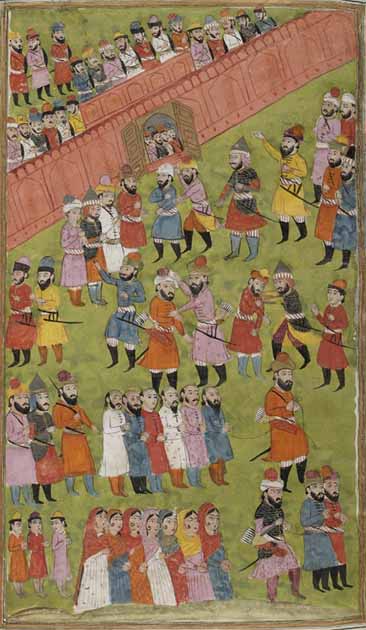
The massacre of the Banu Quarayza Jewish community of Yathrib, which possibly never happened (Public Domain)
Yathrib was largely pagan, but also had a significant Jewish population. The Jews stood side by side with the other citizens to fight Abu-Kariba. This turned out to be lucky for Abu-Kariba, as during the siege he fell severely ill, and his own people lacked the knowledge required to treat him.
Two Jewish scholars, who were skilled in medicine, risked their lives by visiting Abu-Kariba in his camp. Their treatments were successful, and Abu-Kariba was soon on the mend. While treating the king, the two men begged him to bring an end to the fighting and make peace.
Abu-Kariba went even further. He ended the siege and converted himself and his entire army to Judaism on the spot. He then took the two scholars back home to help lead the conversion of his entire kingdom.
At first, there was a lot of resistance; historically, people often react badly to being told what to believe. However, as news spread of what the Jews had done to save their king, more and more Himyarites willingly converted.
Abu-Kariba did not live happily ever after however. His turn to Judaism did little to stem his military ambitions, and his military campaigns continued unabated. This may have led to his death. We do not know for sure how Abu-Kariba died, but some historians point the finger at his soldiers.
- The Kingdom of Axum: Facts and Legends of a First Millennium Powerhouse
- Abyssinia and the Ethiopian Empire: The Ancient History of a Struggling Nation
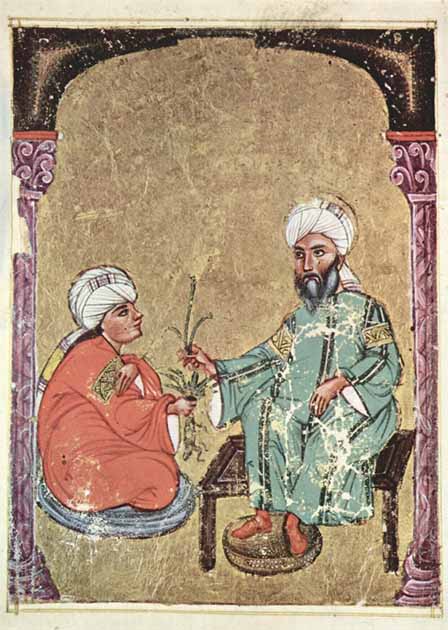
2nd century Arabic medicine was unable to save Abu-Kariba, and his treatment by Jewish scholars led to his conversion, as well as his troops and kingdom (Public Domain)
Himyarite Persecution of the Christians: War with Axum
Although the tale of Abu-Kariba converting to Judaism out of gratitude is a nice one, it isn’t the whole story. There were likely political reasons at play.
Himyarite’s messy history with Christianity dates back to 313 AD and the edict of Milan. This granted tolerance to all religions (including Christianity) within the Roman Empire. Shortly afterward, the Kingdom of Axum, which had been Jewish since its inception, converted to Christianity.
Axum had always been the Himyarite Kingdom’s biggest competitor. The Axum Kingdom abandoned Judaism in favor of Christianity around the same time that the push within the Himyarite Kingdom towards Judaism began.
It seems possible that the Himyarite Kingdoms wanted a good reason to continue their decades-old feud with Axum, and what better reason than interfaith tension? Fuel was added to the fire when the Roman Empire fell, and the Christian East Empire rose out of the ashes, based in Byzantium.
The Himyarite Kingdom now had two major Christian rivals. These rivals’ incursions into Himyarite lands were what caused Abu-Karib’s fateful march on Yathrib.
In short, the leaders of all three kingdoms were using their faiths as excuses to expand their borders and pick fights with each other. However, in reality, they were fighting economic and political wars, predominantly over who got to control the spice trade with India.

Control over ancient spice trade may have influenced political and even religious decisions (Wellcome Collection / CC BY 4.0)
Soon, Axum and Byzantine began undermining Himyarite influence by sending Christian missionaries into Arabia. Sadly, this led to the religious persecution of innocent people just going about their lives. The first recorded case is that of Azqir, a Christian missionary.
Azqir met his fate after building a Christian church in Najran during the late 5th century, during the reign of King Shurihbi’il. This was resented by the locals, and he was handed over to some traveling Jewish merchants who were in the area. They took him straight to Zafar to stand trial before King Shurubi’il. Unsurprisingly, his trial did not go well for him and he was sentenced to death, along with 38 other Christians.
Some sources, such as Martyrium d’ Azqir, claimed that two rabbis were part of the trial. However, indigenous sources of the time make no mention of Azqir’s faith during his trial. These indigenous sources focus on the idea that Azqir was spreading Byzantine influence through his teachings.
It is most likely the truth lies somewhere in between. There is little doubt that Azqir was executed for attempting to spread the Christian faith as a missionary. However, the reason this was a problem had little to do with differences in faith. Azqir’s execution was about stemming Byzantine influence. To the Himyarite king, these missionaries were no better than spies sent by Byzantium and Axum to undermine and destabilize his kingdom.
The execution of Christians gave the kingdom of Axum the perfect excuse to invade. By the late 5th century, the Himyarite Kingdom held most of the Arabian Peninsula, but this didn’t last for long. They soon lost the Arabian Peninsula when Axum swept in, putting their kings in power and establishing churches in Zafar.
Between the years 500-522 AD, there are no Jewish inscriptions in Himyar, the kingdom had completely fallen to the Christians. During this period, Himyar appears to have become a tributary state of Axum. There are even records suggesting that the kingdom allied with Byzantium during this period.
The End of the Himyarite Kingdom
The Kingdom of Himyarite would see one last bloody resurgence, however. In 1522, Ma’dikarib Ya’fur, one of the Himyar Christian kings, died. A bloodbath ensued as Dhu Nuwas (517-527 AD) soon seized power, hell-bent on restoring Judaism to the kingdom.
Dhu Nuwas soon got to work either burning churches or turning them into synagogues. The kingdom’s Christian population was forcefully converted to Judaism. Those who resisted were killed, and hundreds of Christians perished in Najran and Zafar.
Dhu Nuwas sought an all-out holy war against Christianity. He planned to create an alliance with the Persian Empire while also mobilizing the Jews in Israel. He hoped this coalition would be able to strike down the Christians of Axum and Byzantium at the same time.
Unsurprisingly, Dhu Nuwas’s treatment of his Christian population horrified the Christian world. Retribution was swift and bloody. A battle at the Strait of Bab al-Mandab took place between Jewish Himyarite forces and those of Christian Axum.
It was a massacre, and the Himyarite forces were crushed. Up to 14,000 men died, and at least as many were taken prisoner). This was the end of the Himyarite Kingdom. It remained under Axum control until around 565 AD when the Persians evicted the Axumites and made the land their own.
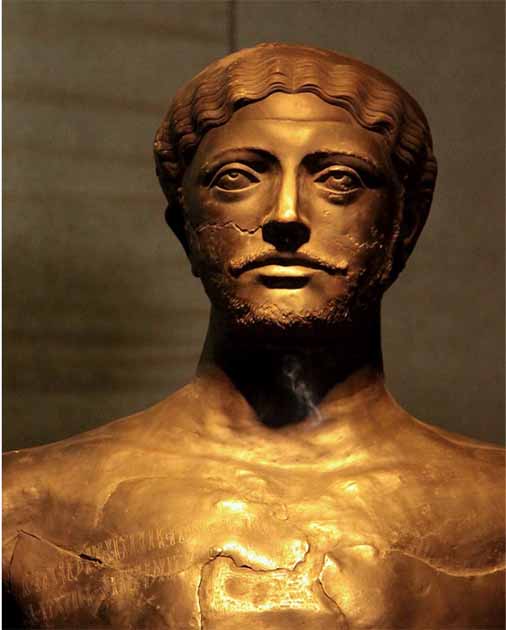
A bronze statue of Dhamar Ali Yahbur II, a Himyarite king who probably reigned in late 3rd or early 4th century AD (Retlaw Snellac / CC BY 2.0)
Conclusion
Like every kingdom before and since, the Himyarite Kingdom was eventually defeated. It is another important reminder that it doesn’t matter how big or powerful a nation is, they all fall in the end.
Religion is frequently blamed for wars, with arguments like without religion there would be no war, or that religion has been the cause of nearly every war. At first glance, the Himyarite Kingdom’s bloody history would seem to support this theory. The kingdom spent most of its existence going to war with its Christian neighbors.
But when we look closer, the wars had very little to do with religion. They were about expanding borders and influence. Each kingdom was desperate to get its hand on the profitable spice trade with India.
To the leaders of Himyarite and their neighbors, religion was only a tool, something they could use to turn their population against their enemies and start bloody wars. In the end, this strategy was the Himyarite Kingdom’s undoing. Dhu Nuwas’s holy war was also his kingdom's death sentence.
Top image: The village and citadel at Thula have their roots in the Himyarite kingdom. Source: fotoember/ Adobe Stock
By Robbie Mitchell
References
Ahmadi, P. 2020. The Himyarites. Rebuild the Middle East. Available at:
https://www.rebuildthemiddleeast.com/history-of-the-middleeast/2020/1/5/the-himyarites-1
Korotayev, A. 1995. Ancient Yemen. Oxford University Press. Available at:
https://www.academia.edu/32711023/ANCIENT_YEMEN_Oxford_University_Press_1995_
Korotayev, A. 1996. A Pre-Islamic Yemen. Harrassowitz Verlag. 1996. Available at:
https://www.academia.edu/32923104/Korotayev_A._Pre-Islamic_Yemen._Wiesbaden_Harrassowitz_Verlag_1996
Tobi, Y. 2017. Kingdom Of Himyar. Oxford University Press. Available at:
















Comments
The part about Abu-Kariba and his army suddenly converting is pretty silly and extremely unlikely on its face. In addition, the guys dad Yuha’amin was literally named after the jewish name for god Yahu, so I think it's safe to say that part is inaccurate.
"Religion is frequently blamed for wars, with arguments like without religion there would be no war, or that religion has been the cause of nearly every war."
People who make such arguments seem to conveniently forget that atheist states have caused the loss of countless human lives as well, in a not so different effort to force people to abandon their faith. Most notably the former Soviet Union and China, which just during Mao's regime alone likely caused more deaths among the civilian population that all the religious wars of the Middle Ages.